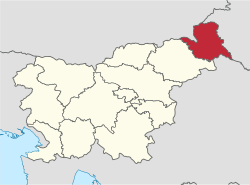Mura Statistical Region
Statistical region From Wikipedia, the free encyclopedia
The Mura Statistical Region[2][3][4][5] (Slovene: pomurska statistična regija) is a statistical region in northeast Slovenia. It is predominantly agricultural with field crops representing over three-quarters of the total agricultural area (twice as much as the Slovene average). Climate and soil combined have made it the region with the highest crop production, but its geographical position and inferior infrastructure put it at a disadvantage and it is the region of Slovenia with the lowest GDP per capita (EUR 12,267) and the highest rate of registered unemployment.[6]
Mura Statistical Region
pomurska statistična regija | |
|---|---|
 | |
| Municipalities | 27 |
| Largest city | Murska Sobota |
| Area | |
• Total | 1,337 km2 (516 sq mi) |
| Population (2020) | |
• Total | 114,238 |
| • Density | 85/km2 (220/sq mi) |
| Statistics | |
| • Households | 44776 |
| • Employed | 33623 |
| • Registered unemployed | 9094 |
| • College/university students | 4133 |
| • Regional GDP (2019): | EUR 1,796 bn (EUR 15,705 per capita) |
| HDI (2022) | 0.868[1] very high · 11th |
Cities and towns
The Mura Statistical Region includes four cities and towns, the largest of which is Murska Sobota.[7]
| Rank | Name | Population (2021)[8] |
|---|---|---|
1. |
11,025 | |
2. |
3,308 | |
3. |
3,103 | |
4. |
2,947 |
Municipalities
The Mura Statistical Region comprises the following 27 municipalities:
Demographics
The population in 2020 was 114,238. It has a total area of 1,337 km2.
Economy
Employment structure: 57.3% services, 39.9% industry, 2.7% agriculture.
Tourism
It attracts 10.2% of the total number of tourists in Slovenia, most being from Slovenia (62.4%).
Transportation
- Length of motorways: 64.5 km
- Length of other roads: 3,103.5 km
References
Wikiwand - on
Seamless Wikipedia browsing. On steroids.
